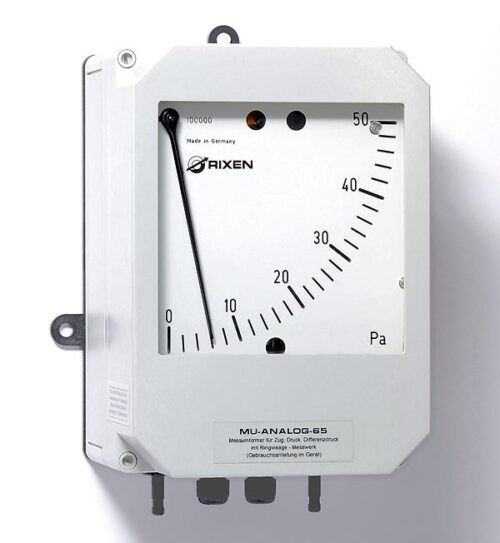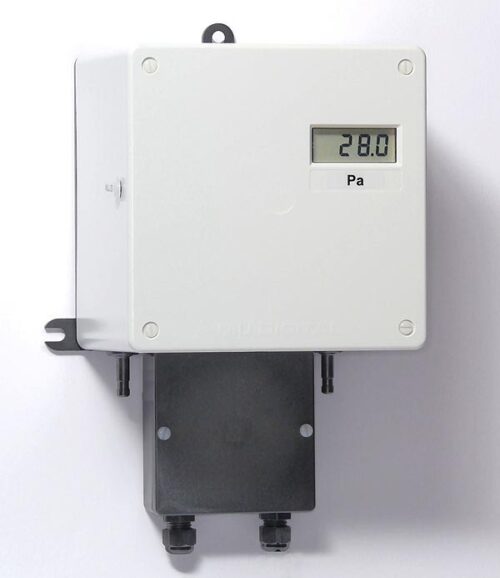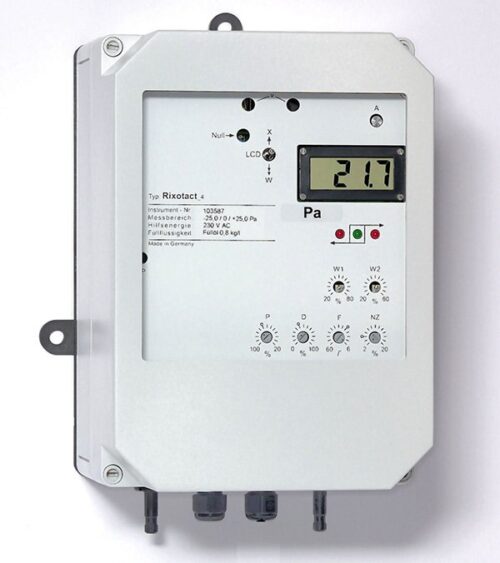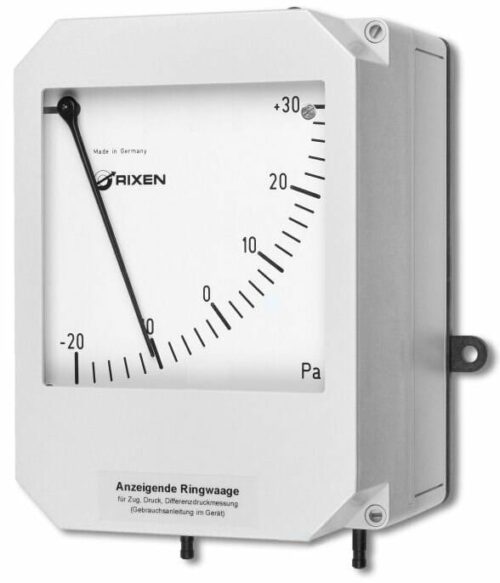-

Type MU Analog: Precise Pressure Measurement with Analog Scale
The Type MU Analog pressure measuring device stands for reliable precision and straightforward handling. The 150×150 mm large analog scale enables a fast and direct reading of the measurement results, making it ideal for applications where a digital display is not necessary or even disadvantageous, such as in the case of pressure oscillations.Main Features
- Analog Scale: The 150×150 mm scale allows for simple and direct reading of the measurements, enabling you to always grasp the current pressure at a glance.
- Ring Balance Mechanism: With its robust and double ball-bearing system, it offers a durable and reliable solution for your pressure measurement needs.
- Measurement Ranges: Flexibly adjustable measurement ranges from 0...40 Pa (+/-20 Pa) to 0...1.8 kPa, including individually definable intermediate values.
- Display Units: A variety of display units are available, including Pa, kPa, daPa, mbar, mmWS, mmCE, and in.W.C.
- Accuracy: A maximum deviation of +/-1.5% of the final value or +/-1.5 Pa.
- Electrical Outputs: The device offers a variety of output options, including 0-20 mA, 4-20 mA, and 0-10 V, facilitating seamless integration into your existing system.
-

Type MU Digital: Differential Pressure Measurement with LCD Display
The Type MU Digital pressure measuring device offers a robust solution for precise pressure measurements in industrial applications. The clear and direct LCD display allows for easy reading of the measurement values.Main Features
- LCD Display: 3 1/2-digit, with a character height of 12.5 mm, clearly and distinctly displays the currently measured values.
- Ring Balance Mechanism: The robust construction, supported by a double ball-bearing system, guarantees reliability and longevity.
- Measurement Ranges: Flexibly usable with measurement ranges from 0...40 Pa (+/-20 Pa) to 0...1.8 kPa, including individually selectable intermediate values.
- Display Units: Various display units are available, including Pa, kPa, daPa, mbar, mmWS, mmCE, and in.W.C.
- Accuracy: With a maximum deviation of +/-1.5% of the end value or +/-1.5 Pa.
- Electrical Outputs: The device offers a range of output options, including 0-20 mA, 4-20 mA, and 0-10 V, to facilitate seamless integration into your existing system.
Pressure types: absolute pressure, relative pressure, differential pressure
In contrast to liquids, air or gases have a decisively different property: they are compressible. Gas can be compressed. Compressed gas has very different properties. When the gas is compressed, it heats up. But when it relaxes, it cools down considerably. This is how refrigeration compressors are operated, for example. However, gas in closed systems reacts to the surrounding air pressure. If the pressure outside decreases, the pressure inside the container also decreases. However, if the external pressure increases, the pressure in the closed system also increases.
Of course, this reaction is largely determined by the deformability of the container. Nevertheless, it is very important to differentiate clearly between the individual types of pressure. Otherwise, miscalculations and even accidents can happen.
The pressure types commonly used for gases are
– Absolute pressure
– Relative pressure
– Differential pressure
The surrounding air: the absolute pressure
The absolute pressure is the surrounding air pressure. A “zero bar pressure” therefore describes the absolute vacuum. At sea level, the absolute pressure is about 1 bar. At the top of Mount Everest, however, the air pressure is only about 0.3 bar. On the shore of the Dead Sea, the deepest landscape on earth, the air pressure is 1.07 bar. This shows that it is very important for the design of systems to consider the installation site. A system that functions at sea level can malfunction at high altitudes.
How strong the one bar air pressure at sea level is can be demonstrated with a very simple example: The brake booster in a car uses the air pressure to double the driver’s pedal force. To do this, a vacuum is permanently generated in the brake booster. When the brakes are applied, the surrounding air pressure presses down on the master brake cylinder. If, however, the car is allowed to roll without the engine running, the vacuum is released at the latest after the first braking process and considerably more force is required to release the brake.
The internal pressure in relation to the air pressure: The relative pressure
A flat bicycle tire still has a bar air pressure. If you would seal the hole and climb a high mountain, the tire would inflate again. The reason is that the remaining residual pressure in the tire expands and thus widens the tire. So to ride a bike at sea level, the air pressure in the tire must be added to the absolute pressure. The resulting gas pressure in the closed system – in this example the bicycle tire – must therefore always be considered relative to the surrounding pressure conditions. This does not necessarily have to be the atmospheric pressure.
One application where the relative pressure must be considered very precisely is, for example, diving technology. Diving watches, gas pressure cylinders, submarine bodies or diving capsules must always be designed in such a way that they can absorb the external pressure without damaging the internal systems by excessive backpressure. The permanent determination of the differential pressure is therefore indispensable for these applications.
Should and have: the differential pressure
The differential pressure is a calculated quantity which results from the difference between an internal and external pressure. What a pressure gauge indicates is therefore always a differential pressure, as it always measures the difference between an external and internal pressure. The differential pressure can be measured in many different ways. The simplest measuring instruments for determining differential pressure are Bourdon tube pressure gauges. Our high-precision differential pressure gauges work with ring balances as a measuring mechanism to determine the differential pressure. In between, there are numerous other measuring methods to determine the differential pressure according to requirements (piezo, diaphragm, etc.).
Differential pressure gauge – Differential pressure sensor for low pressures from Rixen
Our differential pressure gauges can be used with either analog or digital display.
Available in various housing versions ( IP42, IP65 ) for normal use or for use in Ex zones.
Differential pressure sensors for low pressures from Rixen Messtechnik have the 3 common signal outputs ( 0-10V, 0-20mA and 4-20mA ).



